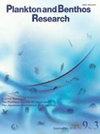Settlement patterns of two sesarmid megalopae in the Sai River Estuary, Ishikawa Prefecture, Japan
IF 0.9
4区 生物学
Q4 MARINE & FRESHWATER BIOLOGY
引用次数: 1
Abstract
Two semi-terrestrial crab species, Chiromantes haematocheir and Chiromantes dehaani, are closely related and have a sympatric distribution. The ecological characteristics of these species, including habitat and behavior during the adult stage, have been investigated. However, the larval stage remains poorly understood because it is difficult to identify larvae morphologically. Our study objectives are to clarify the settlement patterns involved in recruitment of the two species of megalopae using genetic analysis and the effects of ecological factors on settlement, including 1) seasonal changes, 2) spatial variations (dominated by conspecific or heterospecific adults), and 3) tidal effects. The Chiromantes megalopae were collected in the lower reach of the Sai River during spring and neap tides from August to November 2017. Megalopa larvae were collected from three areas: one dominated by C. haematocheir adults, one dominated by C. dehaani adults, and a revetment area. Both species of megalopae showed seasonal and spatial variations in settlement, which also differed with tidal fluctuations. Chiromantes dehaani megalopae settled from midAugust to early October and C. haematocheir megalopae settled from early September to early November. Chiromantes haematocheir megalopae preferentially settled in the area dominated by conspecific adults over the area dominated by C. dehaani and the revetment area, while no difference in the settlement of C. dehaani megalopae was observed among areas. Chiromantes haematocheir megalopae returned on the spring tide; however, C. dehaani megalopae showed no tidal pattern.日本石川县西河口两种芝麻籽类的聚落模式
两种半陆生蟹(Chiromantes haematocheir和dehaani)亲缘关系密切,具有同域分布。研究了这些物种的生态特征,包括栖息地和成虫期的行为。然而,幼虫阶段仍然知之甚少,因为很难从形态学上识别幼虫。本研究的目的是通过遗传分析和生态因素对聚落的影响,包括季节变化、空间变化(同种或异种成虫占主导地位)和潮汐效应,阐明两种大翅目昆虫在聚落过程中的聚落模式。于2017年8 - 11月春潮和小潮期间在西江下游采集了巨斑螯虾。采集的大鳞蝇幼虫主要分布在3个区域:以赤色大鳞蝇成虫为优势区、以德哈尼大鳞蝇成虫为优势区和驳岸区。两种蝇类的沉降均存在季节和空间差异,且随潮汐变化而变化。chromantes dehaani megalopae于8月中旬至10月初定居,C. haematocheir megalopae于9月初至11月初定居。大斑赤色螯蟹在同种成虫优势区比在大斑赤色螯蟹优势区和驳岸区更倾向于定居,而大斑赤色螯蟹在不同地区的定居没有差异。巨斑Chiromantes haematocheir megaloopae在大潮中返回;然而,巨藻C. dehaani megalopae没有潮汐模式。
本文章由计算机程序翻译,如有差异,请以英文原文为准。
求助全文
约1分钟内获得全文
求助全文
来源期刊

Plankton & Benthos Research
Agricultural and Biological Sciences-Aquatic Science
CiteScore
1.30
自引率
0.00%
发文量
32
期刊介绍:
Plankton and Benthos Research is a peer-reviewed journal publishing quarterly original papers, reviews and notes dealing with any aspect of the biology and ecology of planktonic and benthic organisms and their interactions with the environment in any aquatic system, and is open to all scientists around the world. Submission of a paper is held to imply that it represents an original contribution not previously published and that it is not being considered elsewhere.
 求助内容:
求助内容: 应助结果提醒方式:
应助结果提醒方式:


